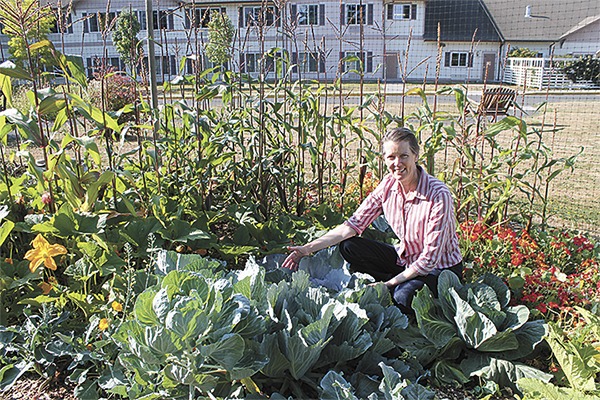By SARAH LOW
For The Beachcomber
For six years, the vegetable garden at Vashon Community Care (VCC) presented volunteer Julia Lakey with a problem.
Given its location on the property and her busy schedule, consistent watering was difficult. After a visit to a “dry farm” in Sequim last summer, Lakey thought she might have the answer.
Now, healthy vegetables are in abundance — all thriving with no water other than rain.
Lakey is a retired teacher who currently spends her time as a housepainter and gardener. Six years ago, she was inspired to volunteer to plant and maintain a vegetable garden at VCC.
“My mother is a resident here. I would come to visit her, and I would look around and think, ‘If I were living here, that’s something I’d like to have,’” she said. “And I’ve always loved dirt and soil.”
The garden is located across the driveway on the site of the old nursing home, making access to water difficult. Several methods have been tried over the years but nothing worked particularly well, especially given the time constraints of both Lakey and her volunteers. The financial impact of her project was also a concern for Lakey, who noted that all of the garden expenses are covered through donations except the water costs.
“The Center has to pay for the water they use, so watering the garden was costing them money,” she said.
Late in the summer of last year, Lakey paid a visit to the “dry farm” run by Paul Gautschi in Sequim. The farm and Gautschi’s method of cultivating his plants without adding water after they have germinated have been documented in both a video, “Back to Eden,” and print, with stories that have run in local newspapers and Sunset magazine. When Lakey saw how successful his farm was, it occurred to her that this could be the solution that she needed for the garden at VCC.
“I needed a low-maintenance idea with a water solution that would save money. I didn’t know if it would work,” she said. “It was an experiment.”
An experiment that has paid-off. With donations from multiple island businesses and organizations, including Sustainable Vashon and the island sawmill, Lakey was able to grow the dry-garden. Very large amounts of wood chips or mulch is the key; from 12 to 18 inches is recommended. This slows the evaporation of moisture from the soil, Lakey said, holds in whatever rain falls and keeps weeds from proliferating.
Lakey planted the garden in late March, and the only water it has had since April has been rain. The results are obvious now, as vegetables such as cabbage, shoulder-high corn, broccoli, chard and kale have all flourished.
The only difference, Lakey noted, is that the plants seem to take a little longer to develop and some may not be quite as big as they might be using conventional methods, but otherwise everything is healthy and thriving.
While this waterless success would be a good fit for the Island Ingenuity Tour, where islanders can showcase the ways they’ve chosen to simplify their lives, save money, and conserve resources, it doesn’t take place until later this fall. Lakey encourages those interested in the garden and the dry method not to wait.
“Now is really the time to see it. The weather has been so dry; this is test-time,” she said. “By the end of September, everything will be harvested.”
Surveying her garden surroundings, Lakey said she is pleased with the results and would like to do more — but with a caveat.
“There is room to expand”, she said, “but we’d definitely need more volunteers.”
The dry-garden at VCC is located on the north side of the property and is open to the public.



